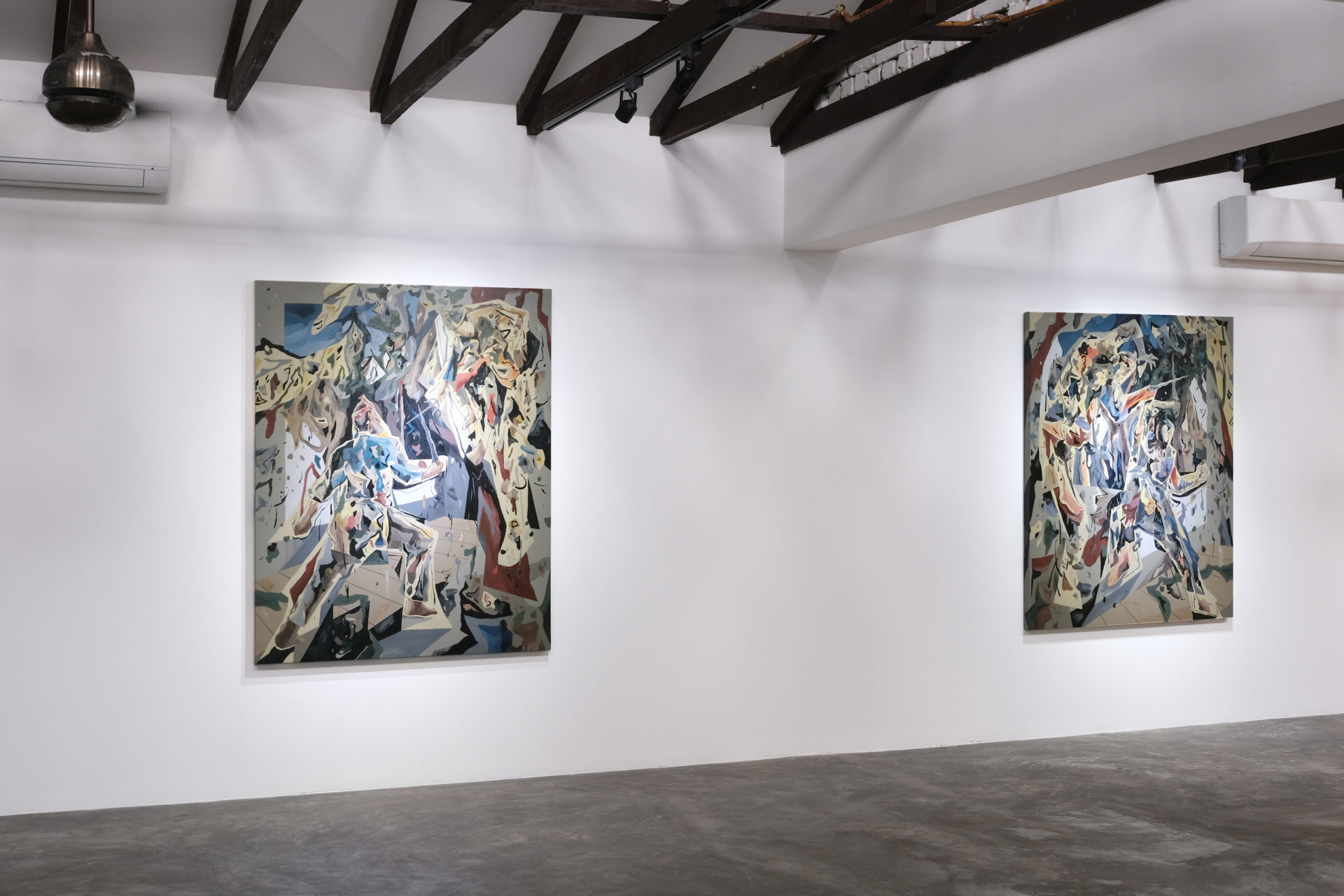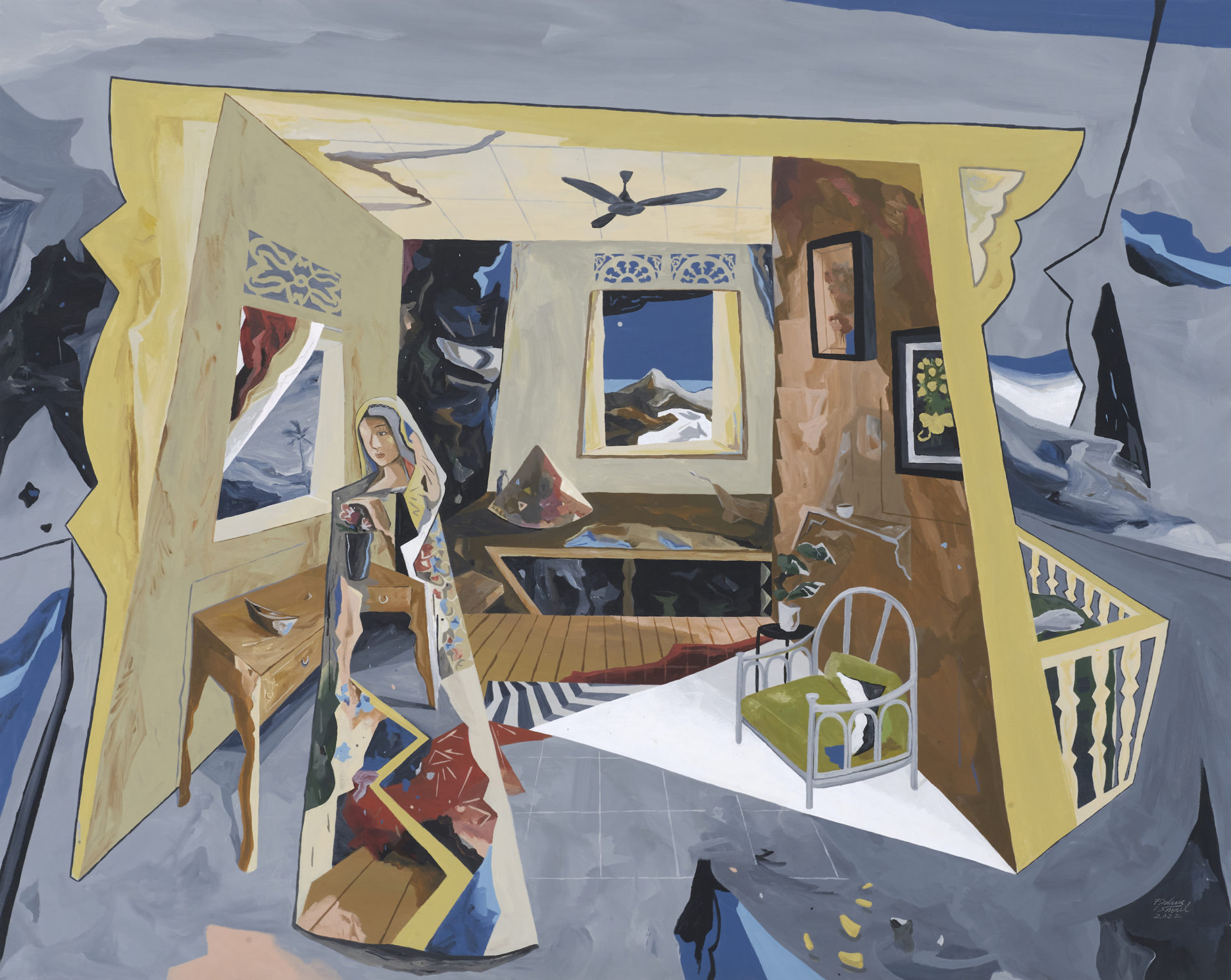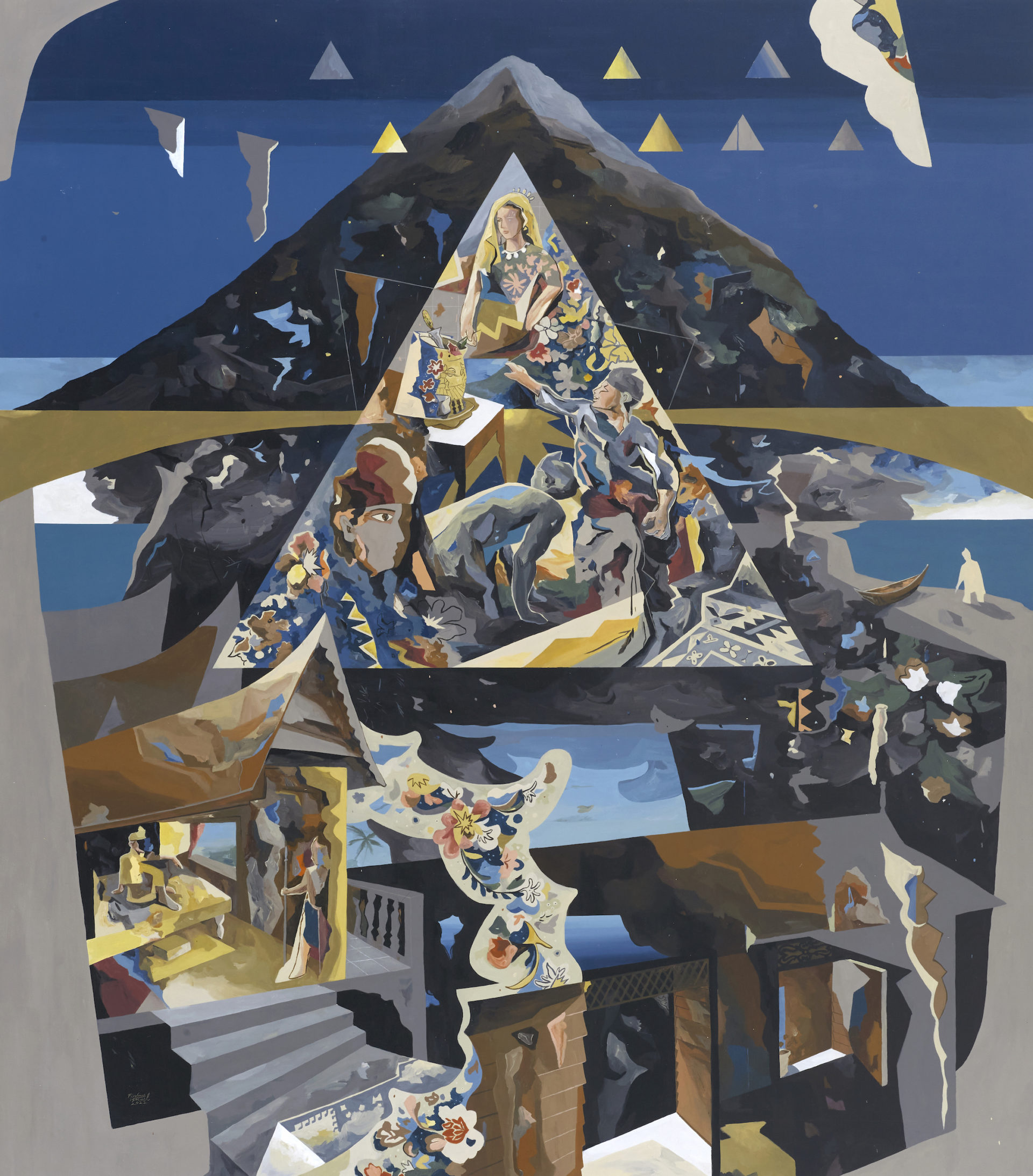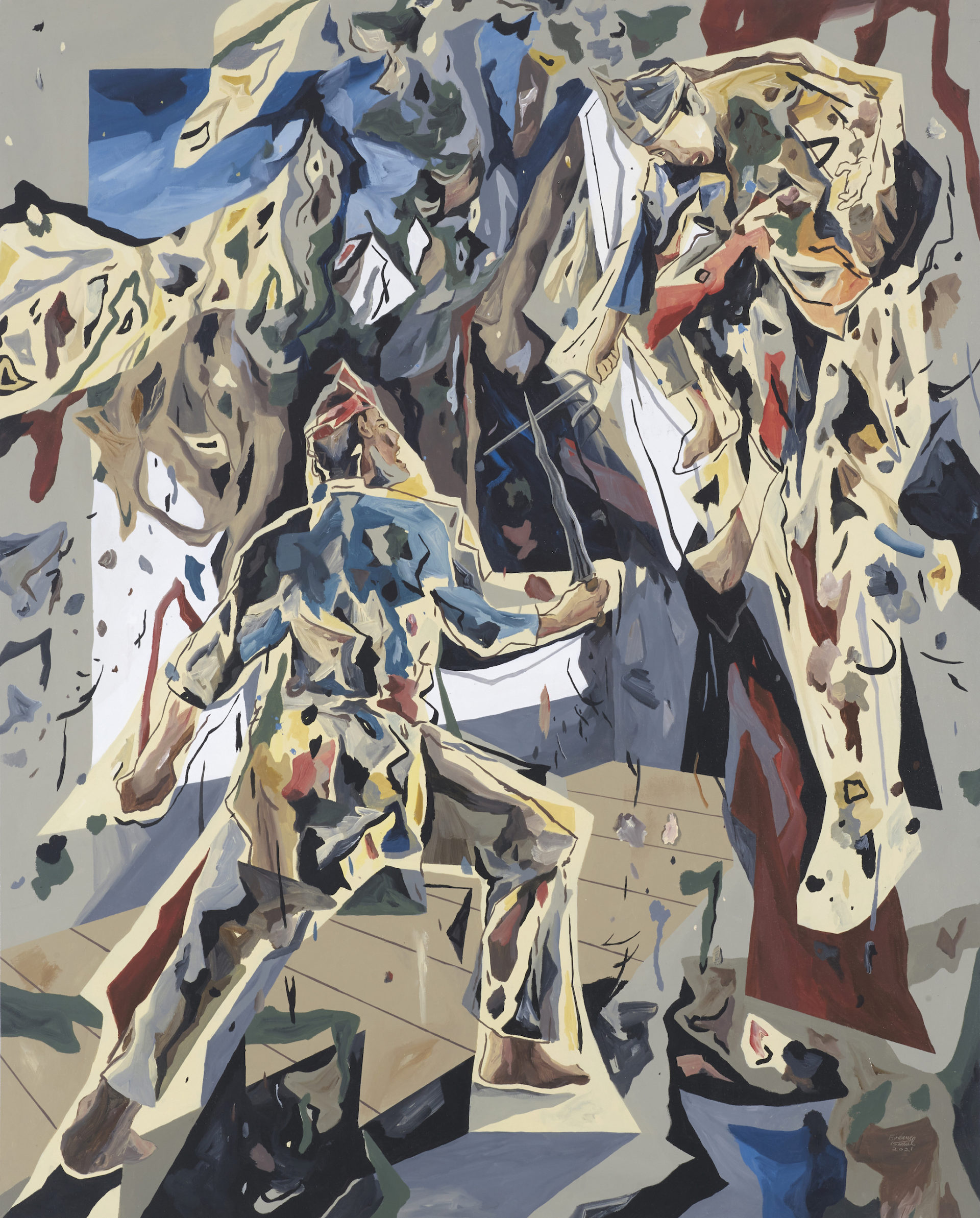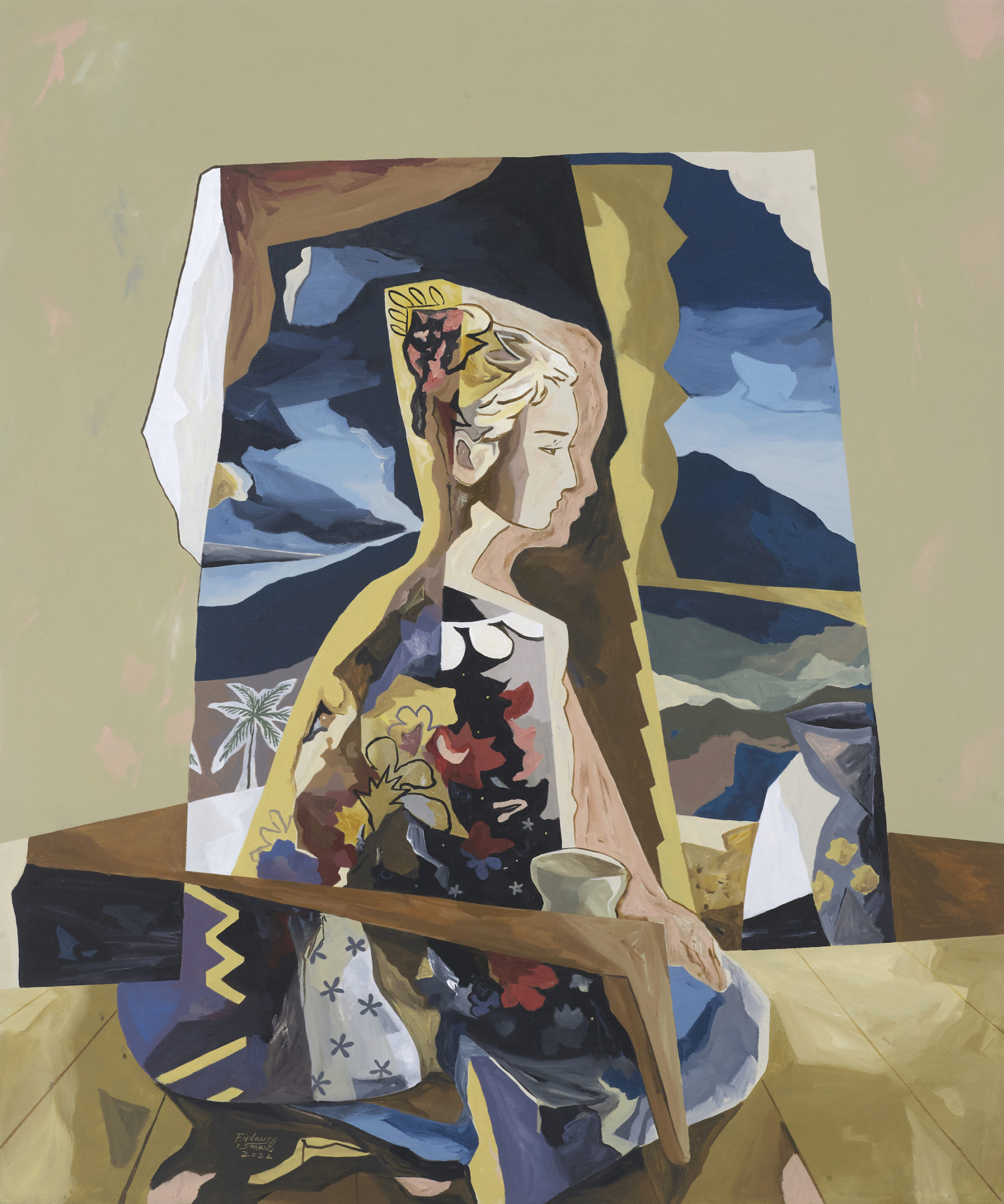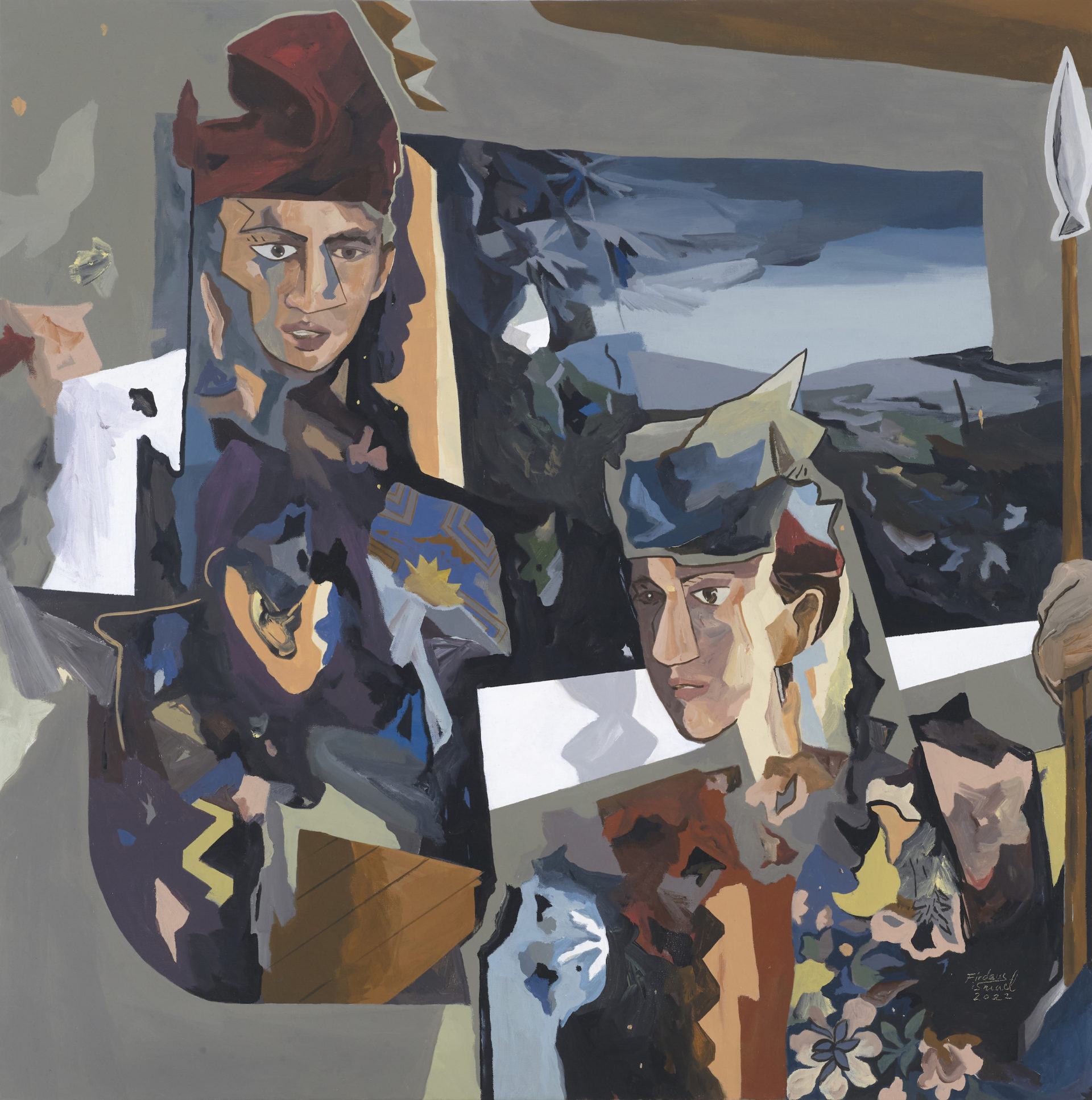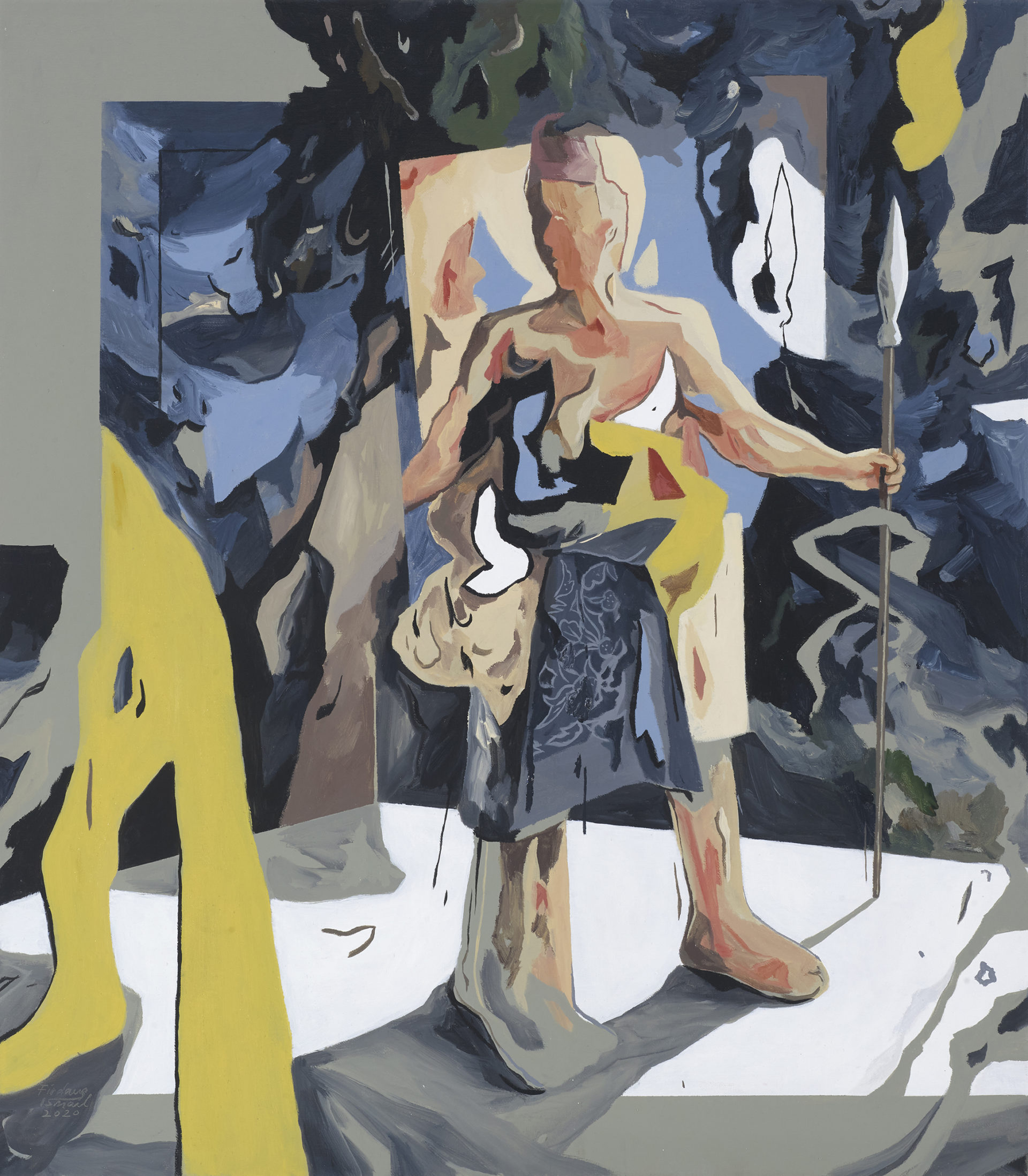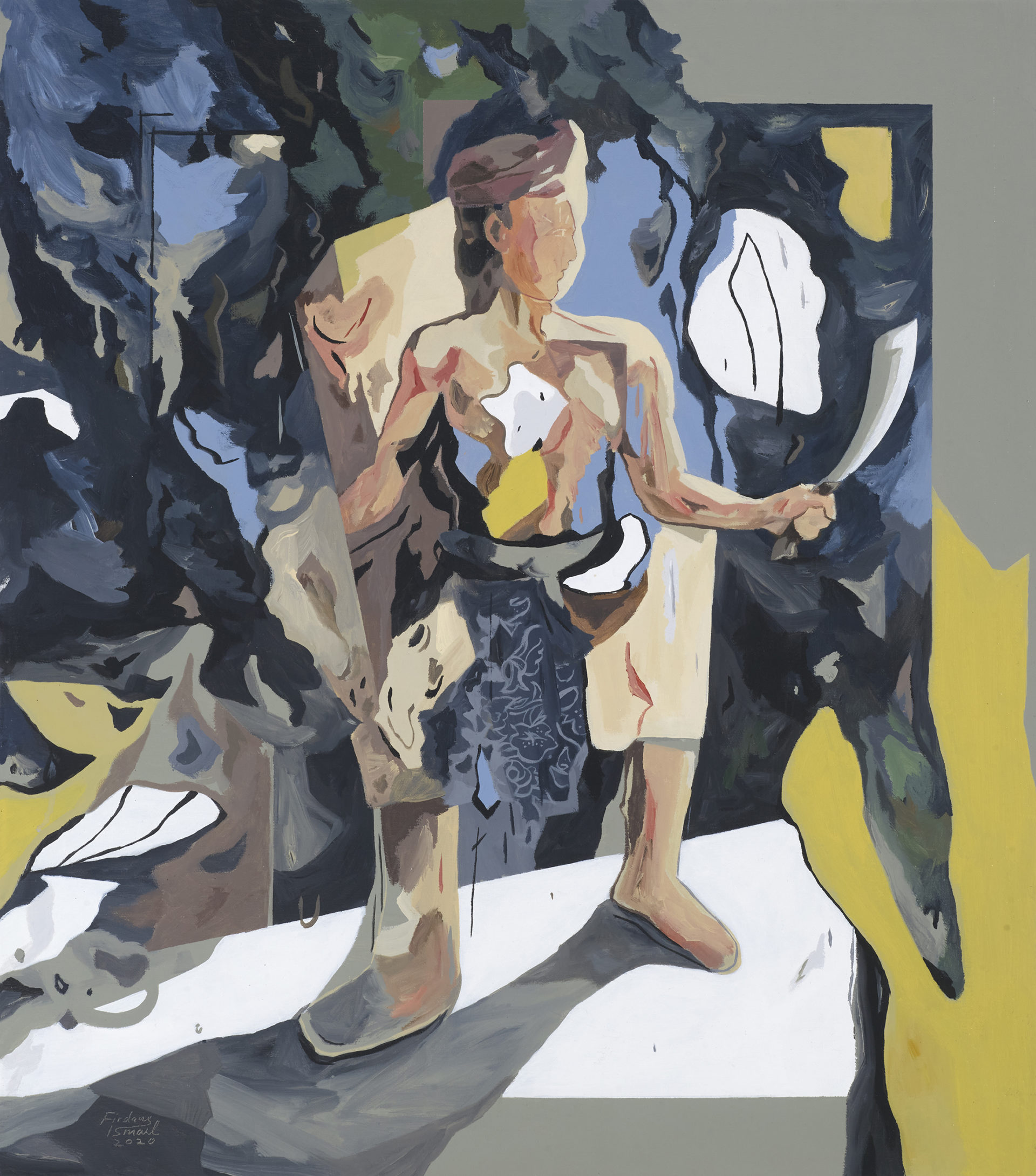Astaka
Solo Exhibition:-
Firdaus Ismail
7th January – 11th February 2023
Core Design Gallery, Subang Jaya
*Click on images to zoom in
by Falil Johari
Recognising a piece of art done by an artist of a particular technique almost always falls under how distinct it looks to one’s eye. To the non-casual observer, it speaks of a highly curious scrutinisation for a painting to inspire a precipitate interest. For how it was visually arresting, it must also contain noteworthy subjects to exchange reasonings and opinions with.
Firdaus Ismail has this exact quality as an artist. Appraised as a young practitioner, his works relayed a form of art that informs contemporaneity, steering spectators to contemplate what they are seeing in order to comprehend. His methodology since his graduation with a BA (Hons) in Fine Art, Majoring in Printmaking at UiTM Shah Alam in 2012 progressed exponentially, with works ranging from figurative, to surrealism, to semi- abstract, or a combination of all three. Firdaus has exhibited extensively from 2009 until 2022, showcasing different approaches that expanded his artistic instincts to an admirable level. From printmaking to painting, it is, without a doubt, his exchanging practices that contributed to his current mode of making.
Investigating the origin of Firdaus Ismail’s interest in Malay folklore, classical, and mythical characters dated back to 2019, when his then paintings — having refined in terms of style — developed a consistency in contextualisation. A few examples can be seen in The Duel I and II; two pieces that are evident with subjects centred around Malay warriors that which was deconstructed and reformed into a western setting. Both paintings were inspired by Orazio Gentileschi, a renowned Italian female painter of the baroque era in the 17th century.
Following this progress in identifying and placing the Malays within contexts in a parallel, yet intriguing setting seemed to be his direction after that. Lebai Malang — After Ibrahim Hussein (2020), The King of Cock Fighters (2020), The Dreamer (2020) and The Dreamer with Starry Night (2020) all alluded to bardic tales, epics, and fairy tales, amongst other genres in Malay folklores. His persistence in unearthing these legends into a contemporary visual is essentially explored in his very first solo exhibition, ASTAKA. Engaging symbolic tradition in oral lores and written works of literature fused with today’s point of view again highlights how ‘contemporaneous’ storytelling in-between eras can be.
Even when all of these stories are orally delivered, and subsequently recorded in written format, their transmission reached and instigated a period of time that examined itself with intimate moral values. Varied interpretations are still very much in discussion to this day regarding Malay legends, regardless of format. The book Malay Annals, or Sulalatus Salatin, is being studied academically and extensively, at one time listed under UNESCO’s Memory of the World Programme in 2001. This particular piece of literature that was composed between the 15th and 16th centuries speaks volumes about recording the common practice of oral tradition — a time when a civilised nation is culturally entrenched with different forms of glorified entertainment.
The oral forms of this lore are transmitted primarily through nursery rhymes, folksongs, theatrical exhibitions, and stories that are commonly told from parent to child. Nomadic storytellers that would roam the temples, marketplaces and palace courts also play a large part in the insemination of the oral traditions throughout the populace, often accompanied by music as well through forms of composed poetry and prose. The oral traditions are often integrated with moral values and some may also include stories of talking animals. [1]
One of the significant stories in the many Malay folklore is Puteri Gunung Ledang (Princess of Mount Ledang), reaching the modern audience when it was popularised in a film in 2004, resulting in a musical theatre — despite both directions were composed as new storylines — due to the immense attention it had garnered. Originally, the story is categorised as a fairytale as it revolved around a metaphysical character/s, Puteri Gunung Ledang/ Dayang Raya Rani herself. The mysticism in this story is retold throughout centuries, describing the Princess as a Bunian or “hidden people” (referred to as ‘makhluk halus’ in Malay), who came from a race with exceptional beauty and grace.
When it comes to this celebrated lore, it is insensible to neglect its metaphysical aspect. Malay storytelling is often inclusive of such things that it is difficult to reject a mystical phenomenon (said, experienced or learned) that grew within the culture at the time. Firdaus further commented that he believes we still reside in a world with parallel existence, which is unseen and unimaginable. His works which predominantly entailed various Malay lore emphasised his genuine curiosity about such a world’s existence.
In the excerpt of Sulalatus Salatin regarding Puteri Gunung Ledang, it is clear that the storyline concluded with morals that define the 15th-century monarchy of the Malay Muslims then. The Princess was rumoured to have an ethereal beauty that rivalled ordinary women, which came to Sultan Melaka’s knowledge who had just lost his Raja Permaisuri Agung. Yearning for a new spouse, he commanded his underlings, Laksamana Tun Mamad and Sang Setia in delivering his wish to marry the Princess. His command was absolute and his underlings were loyal in carrying out the mandate, enduring the adversities and difficulties along their journey to Mount Ledang. Once there, they were met with Dayang Raya Rani, the professed guardian of the Princess — where in truth, it was the princess herself that was under mystic disguise (some interpretations differ, but we shall take into account this metaphysical probability as it was uniformly agreed upon). The infamous seven impossible demands of the Puteri Gunung Ledang expressed by Dayang Raya Rani to Tun Mamad were a subtle way of rejecting the Sultan’s proposal — although the moral values did not end there by how six of the demands could be fulfilled sans one, which was a bowl of Raja Ahmad’s blood, the son/prince of the Sultan.
Puteri Gunung Ledang as a classic fairytale does not stop being interpreted in just literature, film or theatrical form, but also art. Syed Ahmad Jamal was well renowned for his research into Malay traditions and cultures. His works Semangat Ledang (2003) and Tun Mamat Mendaki Himalaya (1984) are exemplified as the pinnacle of Malay modern contemporary art in acknowledging the richness of the Malays’ ‘rupa & jiwa’*, encompassing the aesthetics and Islamic connotations that accompanied it.
“Semangat Ledang” (2003), adalah berasaskan kepada siri karya ‘Gunung Ledang‘ yang menjadi lagenda dan simbol dari aspek alam semula jadi dan alam sekitar. Ia merupakan titik rujukan kepada kegemilangan pensejarahan empayar Melayu Melaka yang masyhur dengan watak Hang Tuah, Puteri Gunung Ledang dan Tun Mamat. “Semangat Ledang” menurut Siti Zainon Ismail (2012) bukan hanya berdiri sebagai mitos sejarah Melayu tetapi juga jauh di belakang telah wujud semangat dunia Melayu dengan simbol gunungan dan pucuk rebung sebagai motif yang memperlihatkan jati diri dan kewujudan kesenian warisan (Muhamad Hanif Hafiz dan Fiqah Qari, 2012). Kebanyakan pengkritik menjelaskan bahawa karya Syed Ahmad Jamal adalah kontemporari yang kaya dan ampuh dengan jiwa Melayu dan Islam. [2]
Borrowing Syed Ahmad Jamal’s concept of Malay and Islamic aesthetics in his paintings added to the point of reference for Firdaus. Synonymously, Firdaus created a version of his own, all the while paying homage to the late famous artist. His work Pendakian Tun Mamat: Dari Astaka ke Puncak Mahligai (2022) sparks immediate recognition with the painting Tun Mamat Mendaki Himalaya (1984) by Syed Ahmad Jamal. Firdaus’s portrayal of Malay legends however clings to a version of storytelling that denotes a theatrical and fantastical sense of style. In this painting, the sequence between scenes can be discerned — from the interior of a Malay house, the Sultan’s palace, the journey to the mountain, and the depiction of multiple characters that are central to the story. The triangle shape — indicating motif tumpal/pucuk rebung — is very much evident, incorporated into the upper portion of the painting, grouping the characters as a symbolical event leading to its climax. Seven smaller triangles are seen on top of it in its designated composition, with Mount Ledang as the background. Floral motifs akin to the concept of Malay batik textiles are also included to emphasise the cultural richness of this legendary story.
In the first few discussions with the artist, the topic of Malay and Islamic values was put at the forefront. There were several dilemmas faced by the artist — questioning the lack of representation of it in contemporary art forms, followed by the need to revitalise an understanding of Malay cultures and traditions. Firdaus’s starting point by referring to past masters is within reason; figures like Syed Ahmad Jamal, Redza Piyadasa, Ismail Zain, Hossein Enas and Mazli Mat Som to name a few were key factors in the widespread art research on Malay cultural identity.
Most notable in Firdaus’s works is how assimilative his subjects are with the contemporary audience. Paintings displaying women seated as a focal point were contextually explained as the ‘anak dara’ in one of the Princess’s seven demands of filling an urn of virgins’ tears*. The portrayal of the women was ambiguously painted in a semi- abstract style, although with further scrutiny, the audience is able to see the urns that are placed beside them. Their expression and position bear resemblance to Redza Piyadasa’s work Seated Malay Girl (1991), as with Mazli Mat Som’s Menanti Nelayan (1965).
Astaka, menurut kamus dewan (edisi keempat) ianya didefinisikan sebagai pentas khas yang dibina untuk sesuatu tujuan. Sementelah saya, dalam cubaan meletakkan/mewujudkan diri ke kancah seni rupa Malaysia, sering kali saya membayangkan bagaimana keadaan/rupa andai diri saya menjadi pancaran cahaya (spotlight) di atas pentas (ruang pameran). Di dalam ruangan astaka itu, saya mungkin juga boleh menafsirkan diri saya sebagai pengarah drama/teater atau boleh juga berperanan sebagai aktornya dengan memainkan watak-watak tertentu. Oleh demikian, sebahagian dari watak-watak ini, saya bagaikan meletakkan diri sendiri sebagai proses mengenal jati diri bagi menghidupkan karekter di dalam persembahan. [3]
His statement about the stage, or astaka, was viewed as an attempt on imitating and implementing a stage-like body of works. His processes are centred on himself as the ‘character’ who assumed all of these roles that are present in the paintings — even becoming the ‘actor’ and the ‘director’. With this thought in mind, he placed himself in the story to identify a sense of self as a modern Malay. Characters like Tun Mamat and Sang Setia in Two Heads (2022) assumed a position of characters with unwavering loyalty, as with the depictions of two warriors fighting in Pertarungan Bersenjata: Keris & Tekpi (2021) and Pertarungan Bersenjata: Keris & Keris (2021) that recounted fierceness and nobleness. According to Firdaus, the fights represent a fight of internal conflicts against the betrayal of self. It is a direct reimagining of pre-fighting in the paintings The Duel I and II, which was visualised as the end of the fight.
For the most part, his paintings translated into an expansion of Malay folklore, deriving its moral values and reevaluating old traditions/practices that seemed to characterise the Malay society at large. Firdaus’s style in introducing folklore feels almost like pure spectacle — his paintings illustrate a phenomenon in a film called ‘breaking the fourth wall’, described below:
The fourth wall is a conceptual barrier between those presenting some kind of communication and those receiving it. The term originated in the theatre, where it refers to the imaginary wall at the front of the stage separating the audience from the performers. [4]
According to Windmill Theatre Co., there are 10 elements of theatre: role and character, relationships, situation, voice, movement, focus, tension, space, time, language, symbol, audience, mood and atmosphere[5]. Firdaus’s works fulfilled these elements to a tee; his paintings depicting Malay warriors, traditional women, and cultural attributes adorned and amplified certain qualities present in a theatre presentation. In the few portrayals of Malay traditional house interiors in his works, he embeds and arranged modern items which clashed vividly against the traditional, as exampled in Interior with Standing Female Figure (2022) and Seated Woman by The Rear Window (2022). Accordingly, Firdaus becomes the ‘property designer’ for these interiors; especially when such ‘designs’ are observable and appear in all of his paintings.
Despite the main theme for ASTAKA being Puteri Gunung Ledang from Sulalatus Salatin, Firdaus retained his interest in also subtly including renditions that have close relations to it. Uji Senjata (2021) and The Watchers I and II (2020) are instances from the film Puteri Gunung Ledang (1961) that ascend Hang Tuah’s character for its Malay warrior qualities; the fight scenes were made to describe a Malay warrior’s unmatched bravery and the readiness to defend their honours — be it for a loyal cause or simply for one’s peace of mind. Seeing the potential of these principled traits follows a need to set a precedent of thorough consideration by ‘structuring’ his paintings.
In a way, we are seeing the paintings of the much-revered story, Puteri Gunung Ledang, as a fantastical story rekindled through the lens of a contemporary Malay artist. At some point in absorbing the details of this abstracted world that Firdaus had concocted, we feel the pulse of its characters manipulated into breaking the wall of this imagined fairytale and into our perception. An alternative form of vision presenting a world that is separated by centuries of venerated oral tradition brought a sense of national pride to Firdaus who deemed such an appreciation should be elevated and celebrated, keeping in mind it is an art form in and of itself.
ASTAKA, from here onwards, is a venture into conceivable, yet unconventional impossibilities.
References:
[1] https://en.wikipedia.org/wiki/Malay_folklore
[2] Mohamad Kamal bin Abd. Aziz, Dr. Rahmah Bujang (2016). Kritikan Seni: Suatu Tinjauan Terhadap Karya- Karya Mohamad Hoessein Enas Dan Syed Ahmad Jamal Sebagai Seni Warisan Bangsa Dan Budaya Melayu. https://ir.uitm.edu.my/id/eprint/53876/1/53876.pdf
[3] Artist’s statement.
[4] https://www.techtarget.com/whatis/definition/fourth-wall
[5] Windmill Theatre Co. (2018). https://windmill.org.au/wp-content/uploads/2018/09/Elements-of-Drama.pdf




